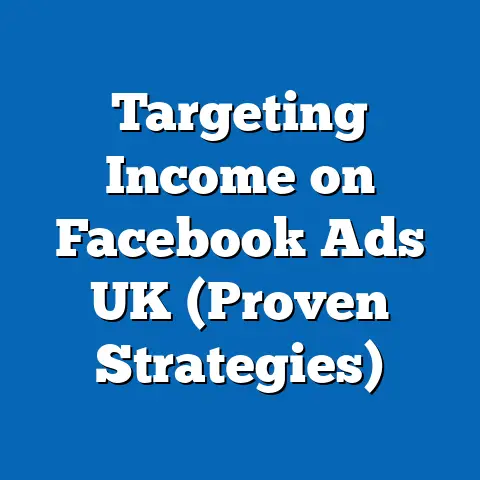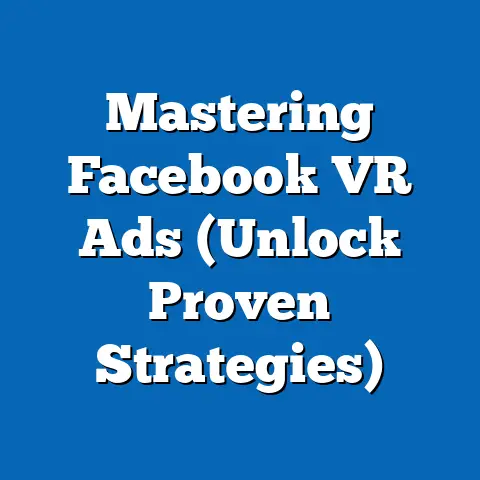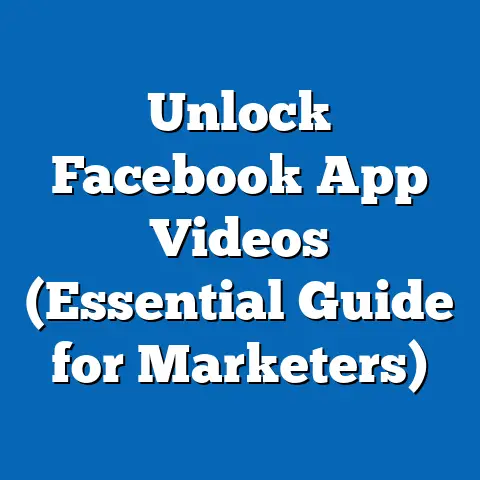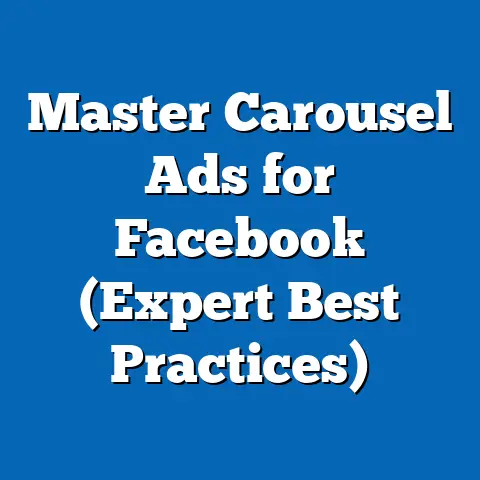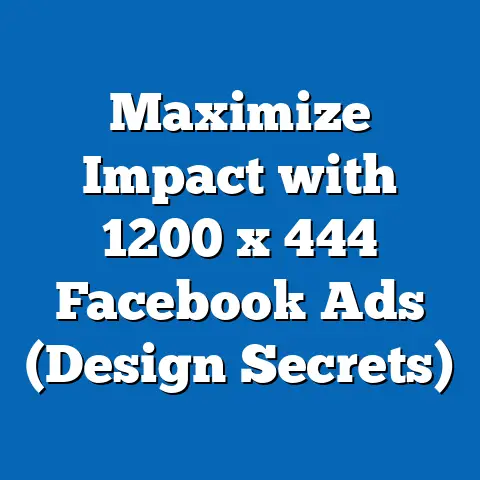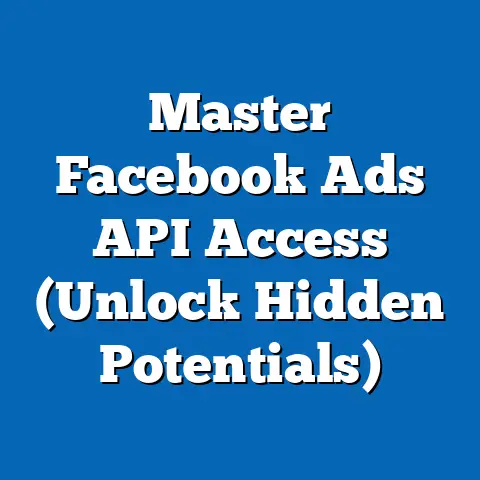Boost Engagement: Bypass Facebook Video Ad Blocker (Pro Tips)
Facebook. It’s the digital town square, the place where billions connect, share, and discover. And for businesses like yours, it’s a goldmine – a place to connect with your audience and drive sales. But let’s face it, the path to success on Facebook isn’t always paved with roses. One of the biggest thorns in the side of marketers today is the rise of ad blockers, especially when it comes to video ads.
I remember when I first started running Facebook video ads. I poured my heart and soul into crafting compelling content, only to be met with disappointing reach and engagement. It felt like I was shouting into a void. That’s when I realized the cold, hard truth: a significant portion of my target audience wasn’t even seeing my ads. Ad blockers were silently robbing me of valuable impressions and potential customers.
But I didn’t give up. I knew there had to be a way to navigate this challenge. Through countless hours of research, experimentation, and a healthy dose of trial and error, I’ve developed a set of strategies that have helped me significantly boost engagement and bypass those pesky ad blockers.
And that’s exactly what I’m here to share with you. In this article, I’m going to dive deep into the world of Facebook video ads, explore the impact of ad blockers, and arm you with actionable “pro tips” to help you break through the noise and connect with your audience. Let’s start with a quick fix: think of your thumbnail and the first few seconds of your video as your chance to hook someone. A compelling visual and a clear, concise message can often capture user interest before they even think about scrolling past or, worse, blocking your ad altogether.
This isn’t just about getting views; it’s about maximizing your ad spend, building brand awareness, and ultimately, driving conversions. So, buckle up, and let’s get started!
Understanding the Facebook Video Ad Landscape
Before we dive into the nitty-gritty of bypassing ad blockers, it’s crucial to understand the landscape of Facebook video ads.
Overview of Facebook Video Ads
Video ads have become an integral part of the Facebook advertising ecosystem. They offer a dynamic and engaging way to connect with your audience, tell your brand’s story, and drive desired actions. Whether it’s a short, attention-grabbing snippet or a longer, more in-depth narrative, video ads can capture attention in a way that static images simply can’t.
Think about it: we’re living in a visual world. People are constantly bombarded with information, and video offers a quick and easy way to consume content. Facebook understands this, which is why they’ve invested heavily in video features and ad formats. From in-feed videos to Stories ads to Reels, there are countless opportunities to reach your target audience with engaging video content.
Statistics on Video Engagement
The numbers don’t lie: video is a powerhouse on Facebook. Here are a few statistics that highlight the effectiveness of video ads:
- Higher Engagement: Studies have shown that video ads receive significantly higher engagement rates than static image ads. People are more likely to watch, like, comment, and share videos.
- Mobile Dominance: With the majority of Facebook users accessing the platform on mobile devices, video is the perfect format for capturing their attention on the go.
- Brand Recall: Video ads can significantly improve brand recall and recognition. Seeing a brand’s message in a dynamic video format is more memorable than simply seeing a static image.
- Conversion Rates: When done right, video ads can drive higher conversion rates than other ad formats. By showcasing your product or service in action, you can effectively persuade potential customers to take the desired action.
For example, a recent study by HubSpot found that 54% of consumers want to see more video content from a brand or business they support. This highlights the growing demand for video and the potential for businesses to capitalize on this trend.
Challenges with Video Ads
Despite the immense potential of video ads, advertisers face a number of challenges. One of the most significant is the increasing prevalence of ad blockers. But the challenges don’t stop there.
- Attention Span: Capturing and maintaining attention in a crowded newsfeed is a constant battle. Users are bombarded with content, and you have only a few seconds to grab their attention before they scroll past.
- Relevance: Delivering the right message to the right audience is crucial. If your video ad isn’t relevant to the user’s interests and needs, it’s likely to be ignored or even blocked.
- Cost: Creating high-quality video content can be expensive. From production costs to ad spend, it’s important to ensure that your video ads are delivering a positive return on investment (ROI).
- Algorithm Changes: Facebook’s algorithm is constantly evolving, which means that what worked yesterday may not work today. Staying up-to-date with the latest algorithm changes is essential for optimizing your video ad campaigns.
The Impact of Video Ad Blockers
Now, let’s zero in on the specific challenge of video ad blockers.
What are Video Ad Blockers?
Video ad blockers are software or browser extensions that prevent video ads from appearing on websites and social media platforms. They work by identifying and blocking the code that serves the ads, effectively removing them from the user’s viewing experience.
There are several reasons why users choose to install ad blockers. Some are simply annoyed by the constant barrage of ads and want to enjoy a cleaner browsing experience. Others are concerned about privacy and don’t want their online activity tracked by advertisers. And some are worried about the bandwidth and data usage consumed by video ads, especially on mobile devices.
User Behavior
Understanding user behavior and attitudes towards video ads is crucial for developing effective strategies to bypass ad blockers.
- Ad Fatigue: Users are increasingly experiencing “ad fatigue,” which is a feeling of being overwhelmed and annoyed by the sheer volume of ads they encounter online. This can lead them to install ad blockers as a way to escape the constant bombardment.
- Intrusiveness: Many users find video ads to be intrusive, especially when they interrupt their browsing experience or autoplay with sound. This can lead them to block the ads or even abandon the website or platform altogether.
- Relevance Matters: Users are more likely to tolerate video ads if they are relevant to their interests and needs. If an ad is completely irrelevant, it’s likely to be ignored or even blocked.
- Control is Key: Users want to feel in control of their online experience. If they feel like they are being forced to watch ads against their will, they are more likely to take steps to block them.
Consequences for Advertisers
The increasing use of video ad blockers has significant consequences for advertisers:
- Reduced Reach: Ad blockers prevent your video ads from being seen by a significant portion of your target audience, reducing your overall reach and potential impact.
- Lower Engagement: If your ads aren’t being seen, they can’t generate engagement. This can lead to lower click-through rates, fewer likes, comments, and shares, and ultimately, lower conversion rates.
- Wasted Ad Spend: When your ads are blocked, you’re essentially wasting your ad spend. You’re paying for impressions that are never delivered, which can significantly impact your ROI.
- Inaccurate Data: Ad blockers can also skew your data, making it difficult to accurately measure the performance of your video ad campaigns. This can make it challenging to optimize your campaigns and improve your results.
It’s clear that bypassing video ad blockers is crucial for advertisers who want to maximize their reach, engagement, and ROI on Facebook.
Here are my top pro tips for bypassing Facebook video ad blockers and boosting engagement:Tip 1: Create Engaging and Relevant Content
This might seem obvious, but it’s the foundation of any successful video ad campaign. If your content isn’t engaging and relevant, it doesn’t matter how cleverly you try to bypass ad blockers; your ads will still fall flat.
- Know Your Audience: Before you create a single video, take the time to understand your target audience. What are their interests, needs, and pain points? What kind of content do they enjoy watching? The more you know about your audience, the better you can tailor your video ads to resonate with them.
- Tell a Story: People love stories. Craft a compelling narrative that captures their attention and keeps them engaged. Don’t just focus on selling your product or service; focus on telling a story that connects with your audience on an emotional level.
- High-Quality Production: Invest in high-quality video production. This doesn’t necessarily mean you need to hire a professional film crew, but it does mean that your videos should be well-shot, well-edited, and have clear audio.
- Solve a Problem: Offer valuable information or solutions to your audience’s problems. If your video ad provides genuine value, people will be more likely to watch it and engage with it.
Example: A local bakery could create a video ad showcasing a time-lapse of their signature bread being made, highlighting the fresh, high-quality ingredients. The story is about the care and passion that goes into their product, appealing to viewers who appreciate artisanal food.
Tip 2: Utilize Native Advertising Techniques
Native advertising is all about blending your ads seamlessly into the user’s experience. The goal is to make your ads feel less like ads and more like organic content that fits naturally into their newsfeed.
- Match the Look and Feel: Pay attention to the look and feel of Facebook’s organic content. Use similar colors, fonts, and styles in your video ads to make them blend in seamlessly.
- Don’t Be Too Salesy: Avoid overly promotional language or aggressive sales tactics. Focus on providing value and building relationships with your audience.
- Use Storytelling: As mentioned earlier, storytelling is a powerful tool for engaging your audience. Use your video ads to tell authentic stories that resonate with their values and interests.
- Focus on the User: Make your video ads about the user, not about your brand. Focus on their needs, their challenges, and their aspirations.
Example: A fitness app could create a video ad that features real users sharing their success stories, showcasing how the app has helped them achieve their fitness goals. This feels more authentic and relatable than a traditional advertisement.
Tip 3: Focus on Shorter Video Lengths
In today’s fast-paced world, attention spans are shorter than ever. That’s why it’s crucial to keep your video ads concise and to the point.
- Get to the Point Quickly: Don’t waste time with lengthy introductions or unnecessary details. Get straight to the point within the first few seconds to capture your audience’s attention.
- Optimize for Mobile: Most Facebook users are accessing the platform on mobile devices, so it’s important to optimize your video ads for mobile viewing. This means using a vertical aspect ratio, adding captions, and keeping the file size small.
- Experiment with Different Lengths: Test different video lengths to see what works best for your audience. Some audiences may prefer very short, attention-grabbing snippets, while others may be more receptive to longer, more in-depth videos.
Example: A clothing retailer could create a 15-second video ad showcasing their latest collection, using fast cuts and upbeat music to grab attention. This is perfect for mobile users who are scrolling quickly through their newsfeeds.
Tip 4: Leverage Facebook’s Algorithm
Facebook’s algorithm plays a crucial role in determining which ads are shown to which users. Understanding how the algorithm works can help you optimize your video ad campaigns and reach your target audience more effectively.
- Optimize for Engagement: Facebook’s algorithm favors ads that generate high engagement rates. This means that you should focus on creating video ads that are likely to be liked, commented on, and shared.
- Target the Right Audience: Use Facebook’s targeting options to reach the right audience with your video ads. The more relevant your ads are to the user’s interests and needs, the more likely they are to engage with them.
- Use Retargeting: Retargeting allows you to show your video ads to users who have already interacted with your brand in some way, such as visiting your website or liking your Facebook page. This can be a highly effective way to re-engage potential customers.
- Test Different Placements: Facebook offers a variety of ad placements, including in-feed, Stories, and Reels. Test different placements to see which ones perform best for your video ads.
Example: A travel agency could create a video ad showcasing a stunning destination, targeting users who have shown an interest in travel or have recently visited travel websites. They could then retarget users who watched the video but didn’t click through to their website.
Tip 5: Experiment with Interactive Elements
Interactive video content can be a powerful way to engage your audience and encourage them to interact with your ads.
- Polls: Add polls to your video ads to ask users questions and gather feedback. This can be a great way to learn more about your audience’s preferences and opinions.
- Quizzes: Create quizzes that test users’ knowledge about your brand or industry. This can be a fun and engaging way to educate your audience and promote your products or services.
- Interactive CTAs: Use interactive call-to-action buttons that encourage users to take specific actions, such as visiting your website or signing up for your email list.
Example: A cosmetics brand could create a video ad that features a makeup tutorial, with interactive polls asking users which products they prefer or which look they want to try.
Tip 6: Build Anticipation and Curiosity
Teasing your video content can be a great way to pique your audience’s interest and encourage them to watch instead of skipping.
- Create a Teaser Video: Release a short teaser video that hints at the content of your full video ad. This can be a great way to generate buzz and anticipation.
- Use Intriguing Headlines: Write compelling headlines that grab attention and make people want to learn more.
- Ask Questions: Ask thought-provoking questions that spark curiosity and encourage users to watch your video to find the answers.
Example: A new restaurant could release a teaser video that shows glimpses of their delicious food and stylish ambiance, without revealing too much. The headline could ask, “What’s the buzz about the hottest new restaurant in town?”
Tip 7: Create Shareable Content
Creating content that users want to share is a great way to bypass ad blockers and reach a wider audience. When people share your video ads with their friends and family, it’s seen as a genuine recommendation, which can be much more effective than traditional advertising.
- Be Funny: Humor is a great way to make your video ads more shareable. If you can make people laugh, they’re more likely to share your content with their friends.
- Be Inspirational: Inspirational content can also be highly shareable. Share stories of success, resilience, and overcoming challenges.
- Be Informative: Provide valuable information that people can use to improve their lives. This can be anything from tips on how to save money to advice on how to improve their health.
Example: A non-profit organization could create a video ad that features a heartwarming story of how they’re helping people in need. This is likely to be shared by users who want to support the organization’s mission.
Measuring Success
So, you’ve implemented these pro tips, but how do you know if they’re actually working? It’s crucial to track your engagement metrics and measure the success of your video ad campaigns.
Tracking Engagement Metrics
Here are some key performance indicators (KPIs) that you should focus on:
- Reach: The number of unique users who saw your video ad.
- Impressions: The number of times your video ad was displayed.
- Views: The number of times your video ad was watched for at least a certain duration (e.g., 3 seconds, 10 seconds).
- Engagement Rate: The percentage of users who engaged with your video ad (e.g., liked, commented, shared).
- Click-Through Rate (CTR): The percentage of users who clicked on the call-to-action button in your video ad.
- Conversion Rate: The percentage of users who took the desired action after watching your video ad (e.g., purchased a product, signed up for a newsletter).
- Cost Per View (CPV): The average cost you paid for each view of your video ad.
- Return on Ad Spend (ROAS): The amount of revenue you generated for every dollar you spent on your video ad campaign.
Tools and Resources
There are a variety of tools and resources that can help you track your engagement metrics and measure the success of your video ad campaigns:
- Facebook Ads Manager: Facebook’s built-in ad management tool provides detailed data on the performance of your video ads.
- Google Analytics: Google Analytics can help you track the traffic and conversions that result from your video ad campaigns.
- Third-Party Analytics Tools: There are a number of third-party analytics tools that offer more advanced tracking and reporting features.
Conclusion
Bypassing Facebook video ad blockers is a challenge, but it’s not impossible. By creating engaging and relevant content, utilizing native advertising techniques, focusing on shorter video lengths, leveraging Facebook’s algorithm, experimenting with interactive elements, building anticipation and curiosity, and creating shareable content, you can significantly increase your reach, engagement, and ROI.
The key is to constantly test, optimize, and adapt your strategies to stay ahead of the curve. What works today may not work tomorrow, so it’s important to stay up-to-date with the latest trends and best practices.
I hope these pro tips have been helpful. Remember, the goal is to connect with your audience in a meaningful way, not just to bombard them with ads. When you focus on providing value and building relationships, you’re more likely to bypass ad blockers and achieve your advertising goals.
Call to Action
Now, I’d love to hear from you! What are your experiences with Facebook video ads? Have you encountered ad blockers? What strategies have you found to be most effective? Share your thoughts and tips in the comments section below.
And if you found this article helpful, please subscribe to my newsletter for more insights on digital marketing strategies. Together, we can conquer the challenges of the digital world and achieve our business goals!

